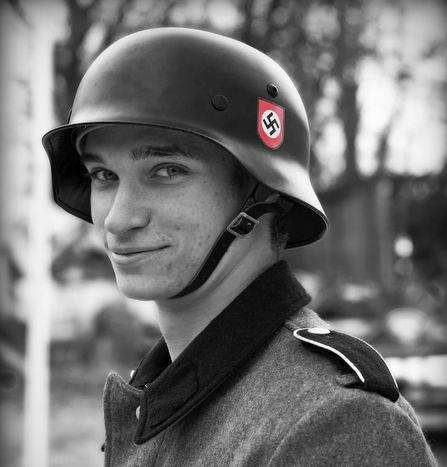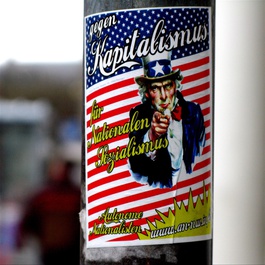
Germany's far-right: style and tea party shakeup
Published on
Boots, bomber jacket, baseball bat - does it sound like your average neo-nazi? As an anti-immigration march took place on the route of a mosque in Duisburg last weekend, remember that for a long time now the far-right extremists in Germany have tried to tone down their appearance in order to gain new followers
The German media like to feed the cliche of the dull thud of boots of nazi boots, albeit acknowledging that the scene has changed dramatically in the last few years. 'Getting into the far-right has changed. They want to heighten their public influence. They go out dressed normally and visually they're harder to recognise,' says Simone Rafael from the Amadeu-Antonio foundation, a civil society initiative promoting democratic culture. Next to the older political parties like the German national democratic party (NPD), the German peoples union (DVU) or the republicans, you can really see this change in policy. 'Free fellowships or associations' ('freier Kameradschaften') - left-wing and centre groups - were created in reaction to the right-wing party bans of the nineties. These informal groups stirred up hatred against dissenters by organising anti-capitalist rock concerts and smear campaigns.
Far right fashion
However, that isn't spectacular enough for the younger generation of neo-nazis. Many of them call themselves 'autonomous nationalists' and imitate the style on the leftist scene. Decked out in hoodies, Palestinian scarves and acting like globalisation critics, the far-right extremists of today use the alternative to be more rebellious. They form into black-clothed marching blocks of anti-fascist groups and use communist symbols with nationalist meanings. This approach is curiously successful. However, there was a group in Berlin called the 'autonomous nationalists' who were taken for 'lefties' and beaten up by neo-nazis.
In any case, the strategy works. Under the cloak of anti-capitalist demands and topics such as animal protection and environmental conservation, teenagers are reached as easily as if via extremist slogans. Military power and violent encroachments with political opponents are still an attraction though, as these relay an anti-democratic, rascist and anti-semitic ideology.
Nice nazi neighbours
Right-wing extremists want to reach a wider part of society with their discourse. This idea shows that the local nazi scene have done their homework. They often sell themselves as the carers of the 'smaller man' says Rafael, who also runs the netz-gegen-nazis.de('internet-against-nazis.de') website. They use social problems to gain support. Should the youth club close? Are their problems with redundancy pay or the nursery? The far-right have a shoulder to cry on when nobody else does. More than this, in areas where there is very little going on, they organise summer parties, football games and get involved with the teams themselves. This is how they convince people in an unpolitical setting that they are 'nice' neighbours.
'They can appear to be normal people, before you find out what they think of jews and migrants'
In comparison, other political movements pretend to be interested in local interests to stir up fear and prejudice. The most prominent German example of this is the citizen's movement ProCologne; in July 2009, people attempted to prevent the building of a mosque during an anti-islam campaign. At first glance (which often goes unnoticed) the far-right extremists want to anchor their rascist and nationalist world vision in the minds of the wider population. For example, a protest against asylum seeker homes is hidden behind a harmless citizen's initiative. 'They can appear to be normal people at first when you first meet them. Afterwards they will reveal what they think of jews and migrants,' explains Sabine Rafael.
State reacts with a ban
 During the 2009 federal elections the right-wing extremists distributed cds and magazines to schools. The content was so cleverly written that it was legally allowed to be circulated. But Sabine Rafael herself feels that society's acceptance of far-right extremists in certain areas of Germany has moved on. 'Rascism and anti-semitic comments are common,' she says. 'That makes it especially important for people to be able to have discussions and attend lectures to be sensibilised towards this. '
During the 2009 federal elections the right-wing extremists distributed cds and magazines to schools. The content was so cleverly written that it was legally allowed to be circulated. But Sabine Rafael herself feels that society's acceptance of far-right extremists in certain areas of Germany has moved on. 'Rascism and anti-semitic comments are common,' she says. 'That makes it especially important for people to be able to have discussions and attend lectures to be sensibilised towards this. '
However there are positive developments, particularly in Saxony, the area in Germany where the most far-right violence takes place. 'Most people dare to contradict the far-right,' explains Sabine Rafel. Only a few years ago Saxony was known for its so-called 'nationally freed zone', where people were hunted if they ddidn't have the 'right' world vision.
Civil society activities aside, the state isn't staying idle. In 2009 the German interior ministry banned two far-right groups, the Collegium Humanum (holocaust deniers) and the homeland-faithful German youth movement (HDJ), which organises the political schooling of its new recruits. Bans alone aren't enough though; these and other groups groups still exist charitably so that people can donate and give their support. More often it seems that propaganda tactics like the 'struggle for minds' ('Kampf um die Köpfe') policy (to attract more left-wing voters) does not work. It's mor important to help the civil society build an awareness of the methods that German radicalism is using to get stronger.
Images: ©originalpozer; 'Autonome Nationalisten' ©Meneer de Braker/ courtesy of Flickr
Translated from Der nette Nazi von nebenan: Das neue Gesicht des deutschen Rechtsextremismus



